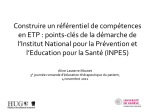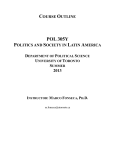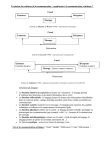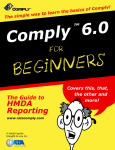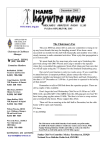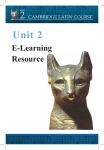Download http://www.henrikjuel.dk Communicative Functions
Transcript
http://www.henrikjuel.dk Communicative Functions -‐ A phenomenological approach to the analysis of media content By Henrik Juel (The following is a 2013 reviewed and translated edition of a paper first presented at the 16th Nordic Conference for Media and Communication Research, Kristiansand, 2003) The communicative and signifying power of modern media using moving images and sound -‐ such as film, TV, video and animated websites -‐ rely to a large extend on traits of the media-‐product or media-‐text that are not easily translated into verbal language or linguistic signs. The expressiveness of gestures, the framing of an object, the movements of the camera, the cuts, and the vertical (synchronized) montage of sound and picture are traits that deserve to be analyzed in their own right as manifest phenomenological and communicative elements. Even though many of these dynamic characteristics may at first seem to be merely a matter of form and of aesthetics they are nevertheless part of the content of the media text and of the overall communication between the producer and the user. In this paper I shall try to show how Roman Jakobson's now classic theory of the six basic linguistic functions can be reinterpreted in a phenomenological frame that will allow the theory now freed of its narrow linguistic or semiotic approach to become a forceful and yet simple tool for analyzing complex communicative functions in modern filmic and digital media. E.g. through the use of concepts like the phatic function, the emotive function, and the referential function it will be possible to explain how the recordings of a handheld camera moving along a warzone street can convey to us -‐ even without the use of any words -‐ not just what this street looks like, but also something like a feeling of fear and excitement, and thereby the understanding that perhaps the photographer (or some protagonist in a fictive universe) is scared, and that war can be an awful experience. The advantage of such a theory of communicative functions is that it can operate with sliding transitions and ambiguity in the shifting emphasis on context dependent traits. A specific camera movement does not always mean the same, but it is always significant, and as a rule it points at several aspects at the same time. Furthermore it becomes possible to analyze the characteristic dynamic features of filmic media or screen media, both the tensions between sound and picture (the vertical montage), and the tensions between before and after (the horizontal montage: cuts and transitions). Last but not least the theory of communicative functions can shed some light on some of the traditional discussions and queries about the alleged truthfulness or objectivity of documentary film or TV-‐news: it becomes obvious that modern media have other obligations and functions than to try to satisfy the very abstract ideals of early philosophical positivism. Jakobson's model In Roman Jakobson's lecture from 1958 (published 19601, hereafter referred to as Jakobson) two models appear, which are structurally very similar, but which deals with something very different. The first model is a communication model, and it presents a survey "of the constitutive factors in any speech event, in any act of verbal communication" (Jakobson, p. 353): CONTEXT MESSAGE ADDRESSER .................................................ADDRESSEE CONTACT CODE With this model we are so to speak looking at a communication process from without and in quite a traditional fashion. There is a sender and a receiver, and in between some other elements need to be in place: there must be a contact or a channel through which a message dealing with something, i.e. the context, can be formulated in terms of a common code or pre-‐understanding. It should be noted, however, that "context" here by Jakobson means something more than just other texts; it is more like "the world" or "reality", that the text is talking about. More surprising and groundbreaking is Jakobson's development of the second model, where he starts to point out how each of the constitutive factors of communication can actually be reflected in the given message understood now as a text or speech-‐act. Here we are looking at the message from within, so to speak, now we have an analytical model that is not concerned with communication processes in general, but with specific statements; it is a text analysis model. We are investigating what can appear in and through the text; we are inside that which in the first model was called the "message". It is this second model I find can be expanded to also cover the analysis of pictures, film, TV-‐programs, web-‐sites, and other modern media products or media texts (others have had similar ideas, especially I want to mention Lisbeth Thorlacius' development of a Jakobson inspired model2. In my adaptation I want to propose only a small terminological change in the original wording of Jakobson's second model: I want to replace his term "metalingual" with "meta-‐communicative" exactly in order to stress that it is now to be applied to all types of messages or texts, not just the verbal or linguistic ones. The model (configured in the same way as the original) then looks like this: REFERENTIAL EMOTIVE POETIC CONATIVE PHATIC META-‐COMMUNICATIVE From linguistics to phenomenological media analysis Jakobson himself is referring to both written and verbal uses of language, sometimes to whole texts and other times to quite short expressions or utterances. From his fundamental linguistic position he talks about the basic aspects of language, verbal messages, and verbal communication -‐ but at the same time it appears from his examples, that he is about to go beyond the narrow verbal sphere and to consider more than just words and their semantic or lexical reference. The tone of voice e.g., belongs also to what constitutes the meaning of a speech or a text. This can be seen from Jakobson's story (p. 354) about the actor at the Stanislawskij Theater, who was capable of communicating forty or more different messages just using the short expression "this evening". Jakobson also mentions that infants are "prone to communicate before being able to send or receive informative information" (p. 356). And as he is using this to illustrate one of the functions, the phatic one, which seems to be also on the repertoire of "talking birds", it goes to show that the communicative functions are to be understood in a broad sense and as linked to the specific interaction, the specific phenomenon of signs, the text, which at this particular time and place is exchanged between the sender and the receiver. It can be other things than clear words, it can be an eye contact or babble or a chat, and there is no problem in understanding such phenomena when they are brought to us by means of different media. And with his examples Jakobson is also pointing at another very important feature, namely that the construction of meaning or significance is situational and context-‐dependent, and that it is possible to combine several types of expressions or functions: by words one can say one thing, at the same time as one's tone of voice indicates another, and perhaps the gestures point in a third direction. This is important for the analysis of content in modern screen media where many things seem to happen simultaneously. Content analysis If, however, Jakobson's analytical model is expanded to cover not just verbal text messages but all sorts of media products -‐ and as such be a model for content analysis of communicative functions in general -‐ then at the same time it will be important to delimit it from analysis and descriptions of aspects and conditions lying outside that, which can be experienced (seen or heard) in and through the message or media product itself. How a specific TV-‐program is received by a segment of viewers, or what the producer might possibly have had of good or bad intensions: this falls outside the scope of the model. The model is only dealing with what appears in the product, in the text (now "text" is here including pictures and sound) in the actual TV-‐program or on the web site; features we can point at, when we try to analyze, what is present and what is going on. A specific background color on a web site or a panoramic camera movement in a documentary film: these are features that we can point at in the analytical process and try to interpret: what do they mean, or how do they contribute to the overall meaning or communication of the product? To such a content analysis -‐ which actually could be called an analysis of form as it is really looking at the forms offered in and by the media product -‐ other aspects like what we may have heard or will be hearing about the producer's or director's or the target groups motives, life style, political or sexual preferences, are for the moment placed outside the field of interest. Only that, which comes out in and by the message itself (the text, features of the product), is in focus for the analysis of the communicative functions. To take an example: both the producer on the TV-‐channel and the anchor (host) on the evening news may have a very strong wish to maintain a good contact with the audience (the viewers), and therefore they use the well know technique of turning to different cameras as they pass on from one news item to the next. This act of addressing a new camera conveys a strong sense of contact -‐ the phatic function (as we shall see later) is predominant -‐ as viewers we feel a bit of the same impelling presence known from real life, when a person turns and faces us close up and starts to talk. But sometimes it goes wrong and the TV-‐host looks into the wrong camera, and we see the host in profile. Then it does not help that the intentions of everybody on the set were good, the characteristics of the broadcasted news item has changed, the communication is different, the otherwise continuous or transparent phatic function breaks down and by this it becomes obvious, we notice it once it becomes awkward or even funny. We no longer have (the mediated) eye contact with the host, but we see the host from the side and may become so disturbed or irritated that we do not even hear what the news story was about. And the host will have to turn to "the right" camera, apologizing before continuing. Another example could be a homepage loaded with numerous banners and jingles and advertisements. Even though many users are so accustomed to this that they pay little attention to it in their search for other information or other events on the site, the entire "commercial background noise" must be said to be part and parcel of the actual communication on the site. We may not be persuaded to follow the offered links, to download or buy any of the offered commodities, they may even in some cases seem offensive to us, but nonetheless they belong to the overall "text" of the page. These features are actually there and they are part of the product (successful or not), and they can be the objects of closer examination and content analysis. A commercial site may turn on a very friendly attitude towards the users and assure us with words, smiling faces and warm colors that the company is only there to serve us. That might be very far from the truth and just something constructed by an assistant to a consulting agent specialized in web design. However, the friendly words and images are there on the site as actual phenomena that we can see and investigate and discuss from an analytical point of view, and usually we can agree about what main features are there and what communicative functions they seem to serve. We do not have to agree upon the appropriateness of the design or trustworthiness of the company, and we do not have to have the same individual taste or evaluation when it comes to the different features or forms of appeal on the site, but we can generally agree upon what features and forms are there, what elements of style we can see. The model from Jakobson can help us to discover and interpret how different forms and elements in the site converge and diverge and make up a cluster of communicative functions. The functions and the ambiguity I find it in harmony with Jakobson's basic (linguistic) insight to talk about a model for analyzing the six basic communicative functions in any -‐ and not just verbal -‐ media product. In the following I shall try to make sense of why there should be exactly six basic communicative functions, and why Jakobson's at first sight rather peculiar terms for naming the different functions after all seem rather well chosen. But first of all I want to stress the decisive principle that the different communicative functions appear together, as simultaneous aspects or powers. But in the individual cases -‐ i.e. in different actual texts or media products -‐ different functions can be dominant or decisive even though some of the other functions are still to be seen in minor roles: The diversity lies not in the monopoly of some one of these several functions but in a different hierarchical order of functions. (Jakobson, p. 353) The advantage of the model is that it makes it possible to retain and analyze the ambiguity, the plurality of connotations and double bind, and perhaps also the dissonance and irony, that is so characteristic of the actual use of language and media. Every time we say something face to face and every time we communicate through media we are actually doing several things at the same time. We may not think about it very often but we are all used to read "between the lines", to listen to the tone of voice in order to determine whether it strengthens or weakens the message, to regard the language of the body as possibly contradicting the testimony, and to consider the staging of a historical event on film as both descriptive, entertaining and perhaps also as encouraging patriotism. A computer game with a very aesthetic design and "feel" may inform me that I just died (!) -‐ and immediately prompt me to play again: poetic, referential, and conative features go hand in hand. The weather forecast on two different TV-‐channels might predict very much the same weather for tomorrow, but I prefer watching one of the channels, because I am interested in other aspects of the communication than just the referential function. I might not even care about the weather information at all, but even so I might enjoy the "social" aspect of being addressed by the nice weatherman. In this way it is possible to take the content analysis a step further than just confirminging the rather trivial cliché, that it is not just what is being said or shown that is important, but also how it is being said or shown. Because the non-‐
trivial insight is, that how something is being said or shown, is that, which is being said or shown. The referential function Whenever a media product deals with or points at or displays something about something, some case or subject -‐ and that is of course quite often the case -‐ then the "referential" function is at work. "Referential" comes from the Latin refero (meaning something like: I bring back, I turn myself towards, I give notice) and has as such (it is an irregular verb in Latin) the same root as "to relate". What is being pointed at, is what Jakobson calls the context, that which the message or media product is about. Most often this is something other than the media product or the communication event itself (e.g. a TV news program about the news of the world or in the local community), it is about something "out there in the world" so to speak. The referential function points at something "existing in the real world". However, it is important to be careful not to read a too materialistic or positivistic metaphysics into the model here: what is being referred to does not have to be scientific facts only, it may just as well be ghosts, emotions, values, abstract concepts, an irrational number or the weather tomorrow on a dreamed up planet. As a common example of media products where the referential functions seems to take the lead would be the news on TV. They are obviously about something, different events, people and developments. But it should not be overlooked that other communicative functions are also at work here, and that they sometime become dominant right in the middle of a news program: it could be the (seemingly) social contact with the viewer, or the image of themselves that the anchor or the TV channel so eagerly promotes, the technical facilities or the communication process itself -‐ this last is most evident whenever there is a break-‐down or a breech of conventions. These other aspects also belong to the communication, to the text (in the broad sense of the term) as it is presented. In principle all of the six basic communicative functions are always there, at least potentially, and in the analysis one should always search for all of them and try to identify which ones are especially noticeable or predominant at a specific time or place in the program. But inversely one should not overlook that even the most improbable romantic fiction film or animated sci-‐fi also carries a referential function: it might be about love, friendship, loyalty, the future, or technology. In case such abstract themes are not to be seen quite clearly, one can at least point out that the film is about some sort of person doing so and so, and that there is a space station looking in a particular way where strange events occur etc. Or there is a laser gun in the picture. Here at last we seem to be down to what is often referred to in a somewhat questionable terminology (also Jakobson distances himself from this in his paper (p. 353)) as "the denotative" level, or the level where the picture is "just" a copy or representation of something. As if a picture was nothing but a sign replacing the original thing! It is so much more: Jakobson is not talking about the interpretation of pictures or films in his text, but in trying to expand his theory about the linguistic functions to cover also this, I need to emphasize that a picture is never just at picture of something out there "in reality", it is not just a repeating re-‐presentation. A picture is always also at the same time a presentation for someone made by someone -‐ and this can be seen in the picture (within the frame, so to speak) and in the film -‐ where usually it can also be heard. The laser gun has to be angled, framed and lit in one way or in another way in order to appear in the film, and these qualities (the result of significant choices -‐ or perhaps poor workmanship -‐ on the part of the film crew) can all be seen and discussed. Perhaps the gun looks threatening or even phallic, this we can quarrel about and interpret upon taking point of departure in the actual film (or text of the film, to be very correct). Perhaps the view of the gun is being held for so long in the film that it becomes noteworthy implying not only something on the dramatic level (this gun will probably be used later on) but perhaps also implying the very insisting intentions of the photographer, the editor or director (please take good note of this gun). The length of a film shot is a phenomenon that is given and that we can see and feel has a complex meaning or significance within the context. The length of a film shot is not a simple sign or a re-‐presentation, but it has a communicative function. In a similar way there are more functions at play and more connotations at work than just the merely informative or referential one on a website with a railway timetable. The lay out of it all, the fonts, colors, tables, as well as the explanations of the different symbols are all telling us something about the sender, it is addressing us as viewers in a certain way perhaps urging us into a certain behavior or implicitly referring to at historic genre and celebrating a tradition of public service announcements. As said by Jakobson himself, we could "hardly find messages that would fulfill only one function" (p. 353). Neither short radio news programs nor short text messages on a mobile phone should be regarded by the analyst as simply informative and fulfilling only the referential function. We must look for what other functions are possibly being fulfilled by these products. And it should come as no surprise that a slice of "reality TV" is not just referring to "reality" (or a slice of it), but doing so much more -‐ even though at first one might think its doing less! The emotive function Put shortly the emotive function has to do with what the text in and through itself reveals about the author or sender. In more modern terms the emotive function is the image or the branding in and through the text itself of the implied sender or host of the particular web site or TV program. It may not have any real or morally sound connection to the sender or producer or company or sponsor behind the scene, but a text is most often implying something about its implicit author. The message itself, the media text, can be seen as a "symptom" of how and who the sender is. Another term also mentioned by Jakobson here (Jakobson, p. 354) is the "expressive" function, as it has to do with what is being expressed (perhaps indirectly) about the sender and the sender's attitude towards what is being talked about or shown. To the analyst, looking for the emotive function means to search for elements or aspects of a given media product that as symptoms are displaying something about the characteristics, attitude, and norms of the sender. Is there anything indicating to us that the sender might be angry or ironical (this is mentioned by Jakobson, p. 354), or how else could we possibly characterize the sender: as serious, childish, humoristic, nervous, pertinent, sloppy, young, old, tired, male etc.? All such qualities on the part of the implicit sender are not just indicated by what is being said in so many words or pictures, but also by the style and staging, the mood and the modulation. The etymology of the word "emotive" suggests that it means what stands out from or moves away from something -‐ but it is now often considered a word for what is feeling based, affective or (too) emotional. Jakobson actually tells us that the term "emotive" is preferable to "emotional" (p. 354) and this is worth noticing, as in my experience the two terms are often confounded in popular introductions in textbooks and on the net -‐ and not surprisingly then by students. It seems easy, but it is not very rewarding for the purpose of analyzing what communicative functions are at work in a particular media text, to look for signs of strong feelings and expressions of emotional disturbance or alarming pathos ("pathos" is here to be taken in the ordinary sense, not the strict rhetorical Aristotelian sense in which it belongs to the receiver). It is much more rewarding to look for the whole spectrum of possible attitudes and positions of the sender. This is so, because a very cool, neutral, factual, non-‐emotional speaker announcing the news on TV is also displaying an emotive function. And this is not because the speaker is a bad actor or pretending to be what he or she is not. Not to be emotional and to be clearly disengaged from a subject matter is also a feature we can see and hear and identify and try to agree upon in the analysis of the TV-‐news anchor's performance: it is what we may find when looking for the emotive function. And in that sense the emotive function is much closer to the rhetorical concept of the ethos of the speaker than to the pathos in the audience. In modern media communication like chat, short text messages, and e-‐mail, the use of small face-‐icons, also called "emoticons" are in common use and easily understood ;-‐) They are usually clear examples of the emotive function :-‐) In case the TV-‐news anchor should have very strong, but well hidden emotions deep inside, so well hidden, that what we see and hear is actually a (seemingly) very cool and calm person, then that is what we see and hear and we will put that down in our analysis. If later someone tells us, perhaps the person herself, that at that moment she was strongly moved by what she was taking about, then that does not change the result of the analysis. Not unless we can go back to a recording of the news program and now actually point to some features previously overlooked or misunderstood, and now see a different sort of personal attitude emerge. Likewise the fact that someone claims: "I was so deeply moved by the news" does not make the emotive function predominant in this statement. It is possible to talk about even very strong emotions in a cool or "neutral" way. One could also call it taking about emotions in an "objective" way, but it would be more in line with the theory here to say, that in statements or even a whole TV-‐program about emotions, it may very well be the referential function that is the predominant one much more than the emotive function. An actors expression of strong passion might be very calculated and well rehearsed and in that sense not his own, but when we see the film the gestures, mimics, the tears and the sighs belong to the fictive character in the film that we are following and not to the actor as a private person -‐ unless we for a moment switch our attention from normal film viewing to an interest in the biography of that actor. However, the many different tools of filmmaking can also be used in such a way that what we see and experience is indeed the director's intentions and attitude towards a specific character: whoever is to appear as the villain can be put -‐ literally -‐ in a bad light, the hero can be filmed from an heroic angle and the intended "happy" end can be marked by a happy musical score. Perhaps the most interesting place to look for the emotive function would be in the programs where you would normally expect the referential function to be predominant, i.e. in documentaries and news programs. Here all the features available in the filmic toolbox, i.e. the editing, the camera moves, the light, the framing, the music and ambient sound, can be indicators of the producer's attitude, prejudgment and limited understanding of the subject in question. This is of course most likely to be noticed when the viewer does not agree with the basic views and attitudes of the sender: then the emotive features stand out. As an example a viewer might be very irritated by the fact that a certain politician or head of state is being filmed in an authoritative position and framing, and is allowed a very long and well prepared time on air talking directly to the camera, whereas another politician or some ordinary person in the street is not treated with equal respect and is not allowed to talk directly to the camera. For the analysis of media texts it is important to be aware of these tools and to note what the work of the camera, the sound, and the editor are revealing as signs of the emotive function -‐ also where you are at first not noticing anything that seems out of the ordinary or irritating or obviously emotive. When chief weapons inspector Hans Blix held his last speech in the UN Security Council shortly before the war in Iraq advocating more time to investigate whether there were really weapons of mass destruction in the possession of Saddam Hussein, he was being filmed from the side and from above at a pretty large distance and with a background of inattentive people restlessly handing papers back and forth. Hans Blix here appeared to be not very credible. When around the same time and on the same issue president George Bush and -‐ most noteworthy perhaps -‐ Collin Powell gave their speeches the whole arrangement and the filmic work on the broadcasting was quite different and made the two appear calm, sincere, trustworthy and well-‐informed. The work of the camera alone can make a person seem more or less trustworthy -‐ at least for a while. The conative function The Latin verb conor means that I try or strive or endeavor, and the conative function has to do with the orientation towards the addressee, my attempt at influencing the receiver and have him or her do something. So in the case of a web site or a TV-‐program we should look for how the receiver is addressed or positioned. Jakobson mentions (Jakobson, p. 355) that in verbal language the conative function can be seen in the imperative and vocative expressions that are often even marked as having a separate grammatical form. He also mentions that in these cases -‐ sentences that are not declarative -‐ there is no such thing as a truth function at work. If anyone cries out "long live the queen!" or "eat up!" it does not make any sense to ask whether this is a true or false sentence. The speech acts here do not have a primarily referential or descriptive function. In a way one can say that the conative aspect is the same as the signal function in a message: what elements or aspects of the message can be found as trying to make the receiver do something, or what aspects are pointing at and positioning the receiver? Again it is important to note that it is not the actual receiver, but the implicit one. Advertisements are obvious examples of media products with conative features -‐ at least that is what one should think at first. If and advertisement simply explicitly advises or demands us to chose or buy this and that, then it is of course very easy to point out. But usually it is a bit more complicated: we do know well enough that many commercials are trying to sell us something, but they do not make use of direct imperatives or manifest signs of persuasion. Perhaps the commodity in question is just being shown in the setting of a very luxurious life style. What is then the conative feature? That seems open to discussion, and that is of course not so strange but an integral part of the analysis as continuous interpretation is an integral part of the science of the humanities. Perhaps what one could do would be to point out that the mere focus on the image of the commodity and the repetition of the name is a way of trying to make us notice and remember the product and the brand. The images of styled models in fashionable surroundings are trying to work on and influence our mood, fantasy, and impulses. Because why else should we be shown what we are being shown? Why else this music to these images? Indeed we can often recognize almost immediately that we have landed in the midst of commercials when zapping around between different channels simply by sensing that the lavish pictures, sounds and scenes have no other purpose. However, it needs also to be acknowledged that even very informative and instructive educational films, like an animated user manual for some technical device, also has this aspect: besides being referential, the conative aspect is also there, there are latent suggestions and nudging taking place. The educational film has an aspect of command: "Look here!" and this is more or less inherent in any media presentation an in any announcement that someone is supposed to see or hear (this is where the conative function is overlapping with the phatic function as described below). Each time there is a presentation there is also an intended receiver and an at least potential characterization and appeal in that direction. Even though the media text seems to be dealing exclusively with a description of how to adjust the brakes on a bicycle it is usually possible in the analysis to find conative aspects. E.g. it is implied that you should adjust them properly, and at least that you are able to follow and understand this text. This is most obvious when somehow the intentions of the text are not well received, for example because I do not want to take on the responsibility and to follow the instructions, or when I do not understand the technical terms or the instructions in Dutch. The phatic function The phatic function is evident when there are features of the media product that point to the contact between the addresser and the addressee. Phatic are the signs of the social aspect. One could boldly suggest that a lot of modern media uses primarily seem to undertake this social contact aspect: mobile phones, social web media and other digital platforms often seem to be mainly there for social purposes -‐ we use them as tools of contact much more than to undertake information or education in the traditional sense. It is not so important what is being said or written just as long as one is confirmed in being there, belonging, staying in contact and being a member of the group. In telephone conversations there is usually a lot of phatic features, perhaps due to the fact that the connection might be bad and one cannot see each other, so all the time I have to make sure the other is still there, and also to confirm that I am listening if the other is speaking for a long time. This is where repetition and small interjections come in, like "yes", "aha" and "you know". However, it is not just the use of technical media that makes us inclined to check whether the communication channel is still open or not. It seems to be an inherent feature in everyday communication, also in verbal face-‐to-‐face conversation. In meeting a colleague at work we often exchange words like "How are you?", or "Nice to see you", and these almost ritual phrases are not meant primarily as referential questions about health or as emotive expressions of personal joy, but they are most often just meant as saying: "I recognize that we are here together, and we can communicate". Depending on the tone of voice etc. one can also indicate some specific mood or condition for further communication -‐ like that "I am in a hurry and if you want to say something it needs to be quick and important". Equally, walking up to a bus stop where people, who are total strangers to you, are waiting, you might say phrases like "Nice weather today" or "Oh, it's cold today" and this is not meant as information to the other people about the weather (they most probably know about it already), but an indication that you are ready to strike up a conversation. You recognize the others as potential communication partners and show that there is an open channel. Even if it turns out they are not speaking the same language as you they will usually understand the phatic or social essence of your friendly, opening remark. Also one-‐way mass media have a number of features that can support the phatic function. As mentioned the newsreader and the TV-‐host take great care to be in eye contact with the right camera. Radio shows can even be said to display the phatic function simply by trying to obtain the best possible and well-‐regulated sound for the listener, making excuses for e.g. a bad connection to a foreign correspondent or wind noise in an outdoor recording. Also descriptions of what is not to seen, but important for the continued contact, like "I am now having a guest in the studio" can be seen as belonging to this category. Common phrases sounding almost like jingles, "Stay in tune", can be seen as both phatic and conative. Web sites have of course many phatic features -‐ and as it is often the case the features we are looking for in the analysis become more manifest when they are not working: when the navigation and links does not work, when the lay out does not support easy understanding or easy access to the desired information or entertainment. Even more so the phatic function becomes apparent when there a banners, sounds, animations or other features that try to capture our attention in ways or areas that we find irritating. But also a quiet, stylish, and "normal" appearing website will have phatic features. In a normal film or TV-‐program the many changes of light, sound and scenery have an effect of attracting our attention: not only is it the editing that makes the story interesting once we are absorbed in the universe of the film or TV-‐
program, but it is often also just the flickering images and the dynamic use of sound that attracts us to a screen, that we are passing, or that happens to be in the room where we are sitting trying to do other things. This effect might be deeply rooted in biological instincts of survival (we have a better chance to survive if we do not overlook rapid movements and changes in the sounds around us) but it is nevertheless to be noted in the analysis as phatic features. And this is so not only for the very dramatic or loud uses of filmic technic and web-‐site design. To be in accordance with conventions and traditions of the genre's design and functionality can also be seen as a precondition for staying in contact with the user, and as such even the quiet film and the discrete site can be seen to have "social" or phatic aspects. The meta-‐communicative function Jakobson talks about the "metalingual" function (Jakobson, p. 356), but this I propose named the meta-‐communicative function whenever the model is to be applied to other texts and media products than the strictly language based. The meta-‐communicative aspect is present whenever the text is explaining something about itself, whenever it is so to speak stepping back or up one step in order to look at itself "from the outside". The standard example from Jakobson is lexical information about a word or phrase, but he also notes how we in everyday life performs meta-‐operations when we ask the receiver if he understands what we are saying, and when we ask the person speaking to explain once again what was said. The meta-‐communicative function is thus directed towards what Jakobson calls the "code" being used in the conversation, or we can say more generally that there is something in the text pointing to the common ground, the conventions, and to the specific use of the mutually understandable tools of communication. An example from TV could be the news anchor's remark saying "These are the news for tonight" or, the more modest version, "This is what we have chosen to bring tonight". Or it could be a warning about the upcoming unpleasant pictures from an accident or a warzone. Other examples could be the announcements of the coming program or the program overview, or simply the small, usually transparent, logo of the channel in a corner of the picture. Similarly the trailers, subtitles and running texts or even the copyright mark at the end of a film can be seen as commenting on the rest of the product and in this way performing a meta-‐communicative act. We are quite used to meta-‐comments in different media and are usually not confused by the implied shift in focus and level. In web sites and different screen applications we also find a variety of meta-‐
comments and symbols that seem to be pointing at a different level than the main text. It can be discussed whether the conventional marking of hyperlinks with blue color and/or with underlining is to be interpreted as meta-‐
communicative, conative or what; and equally one can argue about the status of inter-‐textual references: is it meta-‐communicative when a film scene seems to refer to an earlier film? But this is not so strange after all, the different elements of the model are by nature overlapping and are tools for an analysis -‐ an analysis that is part of a dynamic process of trying to understand and interpret what is going on. It is not a distribution of labels to fixed entities, but should reflect the complex situational conditions of communication. A good model can help us to get a clearer view, but it must at the same time not oversimplify the dynamic and ambiguous nature of signification and communication. We are always doing many things at the same time when we are communicating -‐ in the media and in everyday conversations. The poetic function The last function Jakobson describes is the poetic function, which really from the outset was to be the main focus of his paper; the descriptions of the other functions were more or less just preliminary remarks summing up Jakobson's view of language before engaging on the main topic of the conference he was attending, namely just what sort of language or use of language poetry would be. The poetic function is to be noted whenever the message puts focus on itself as a crafted message, whenever the text draws attention to itself as a text; and in my further application of Jakobson's model this means whenever a media product is drawing attention to itself, its form and style and aesthetic features -‐ and most often in a playful or self-‐contained fashion. Here it is worth noticing that "poetic" stems from the Greek poiesis, which means that which has been done, created, crafted, manufactured. Media products that in particular draw attention to their own creative design or styling, e.g. in case of a very good (or very poor) use of the different means of expression, a very impressive (or obtrusive) editing, design, montage, or other aesthetic means, all that should be noted in the analysis as having poetic features. This does not mean that the film, the site or the program has succeeded in any specific or general poetic or aesthetic excellence, it only means that we can recognize features belonging to this realm as foregrounded. Jakobson mentions that you can recite a very long poem because you want to spend as much time talking as possible (a filibusterer), but that does not change the fact that the original text itself has poetic features like rhyme, rhythm and lyrical words. It is not the author behind the text that is important here, nor is it the good or bad intentions of that author, but what we can see in the text itself. I would like to add, whoever, that if we regard not the original words of that poem as the text to be analyzed, but take the actual communicative performance of the longwinded speaker as our case and text (in the enlarged sense of the word), then it might be that the phatic or emotive features become more apparent than the poetic features. From the gestures, tone of voice and whole behavior of the speaker we can infer, that he seems mainly interested in talking for a very long time without interruption. We are so to speak neither trying to look inside the speaker's head or mind, nor trying to evaluate the original poem, we are simply pointing to specific visible and audible features in his performance. As other examples of the poetic function Jakobson also mentions everyday examples of phrases that we chose simply because they sound nice. It does not have to be very sophisticated to be poetic in this sense; even very ordinary commercial slogans can have this quality (e.g. alliteration, rhyme, puns, lyrical qualities). The sensuous aspects are predominant, the text so to speak foregrounds itself as (material or digital) form and style. What Jakobson calls the "poetic" function could also be called the "aesthetic" function just as long as it does not lead to confusion about what it really means. Whether a media product has noticeable features of the poetic or aesthetic kind is not a matter of taste or preferences on behalf of the audience. The features in question are those that we can agree upon are appearing as particularly crafted, designed, shaped, stylized or aestheticized. It is what in particular is appealing to our senses -‐ but perhaps not in any very agreeable way. In the content analysis we try to identify the features in the media product that are displaying craftsmanship, aesthetics, or a certain design effort -‐ and separate from that we can then discuss if it is something we personally like or not, whether it was appropriate for this audience and occasion, and so on. In conclusion Jakobson's second model is operating with six basic functions, because these are to him the six possible directions in which a text can be pointing: it can point to the other five elements in the first model and finally also -‐ in the poetic function -‐ it can be pointing towards itself. Of course one can go on to fine tune the model with subdivisions and it is also possible to argue that some of the functions usually overlap so much that they are hard to distinguish. Or one can try to look for other functions, e.g. inspired by new media forms and media uses: should we include navigation design on web sites as a new type of communicative function? Or will navigation buttons be well covered all ready by the conative and meta-‐
communicative category? I tend to think that the new media forms and media uses are developing sophisticated ways of realizing and continuing the basic types of communicative interaction that we already know from face-‐to-‐face communication -‐ and that as such the basic categories are still sufficient. We interact with our screens and electronic gadgets in perhaps a very technical and advanced fashion, but it is still understandable as resting on basic communicative skills like taking live to another person. I therefore prefer to keep the model as simple as it is, in order to make the first steps of a content analysis easy and safe -‐ if possible. As I have mentioned several times, the functions tend to overlap, and we need to interpret and be cautious, and that is not because there is a flaw in the model, but simply because that is the nature of communication, whether verbal or non-‐verbal, media based or "live": we tend to do many things at the same time, our conversations are so to speak pointing in many directions. As analysts of communication we should be aware that whenever someone is saying something (or presenting a media product) there would in this text (in this product) quite possibly be six different things going on: 1) The referential function: the text is talking about something, a subject matter; it is pointing at something in the world, so to speak, it is descriptive or informative (or misleading) about something. 2) The emotive function: the text is likely to reveal something about the speaker or writer, some attitude or nature of the sender (the implied, not necessarily the real author). 3) The conative function: the text is trying to influence me (the intended receiver), persuade me, and position me, to have me do something. 4) The phatic function: features in the text show that it is trying to establish and maintain some sort of relation or social contact between the sender and receiver. 5) The meta-‐communicative function: some parts of the text might be at a different level explaining or commenting on the communication as such. 6) The poetic function: features of the text might display aesthetic, sensuous aspects, design and craftsmanship making the text appear "playful"; the text exhibits itself as a text form. In modern media a lot of things are going on at the same time -‐ but that is quite often also the case in what seems to be a very simple everyday face-‐to-‐face communication. Taking point of departure in Jakobson's concepts and taking a phenomenological cross media approach to the various events of communication it should be possible to disentangle some of the complexities. 1 Roman Jakobson's lecture was published as "Closing Statements: Linguistics and Poetics" in Style in Language ed. Thomas A. Sebeok, Cambridge, Massaschusetts, The M.I.T. Press, 1960. 2 Thorlacius, Lisbeth: "A Model of Visual, Aesthetic Communication Focusing on Web Sites". In: Nielsen, Janni (red.) Digital Creativity. Vol. 13, No. 2., Maj 2002. Holland, Swets & Zeitlinger, 2002, p. 85-‐98).

















